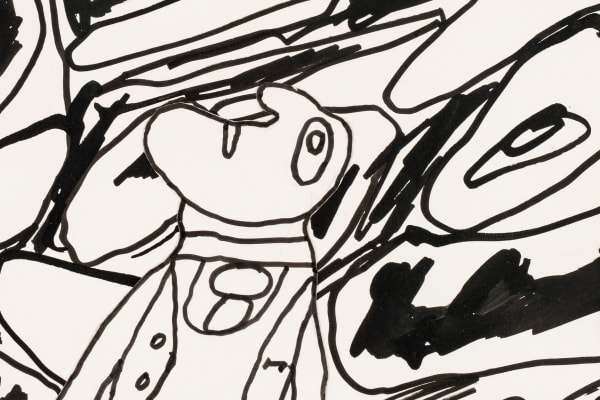
Jean Dubuffet's Paysage avec deux personnages (1980), an ink drawing and collage, is a striking representation of his fascination with distortion and fragmentation. Part of his prolific series exploring the subconscious, this work encapsulates Dubuffet’s deliberate rejection of conventional artistic ideals. Embracing the chaotic and irregular, Dubuffet creates a visual landscape that draws viewers deep into the realm of primal human experience, marked by intricate complexity within a reductionist framework.
The present drawing features two roughly sketched figures, immersed in an abstract landscape of swirling shapes and fragmented forms. Rendered in black ink on white paper, the figures appear disjointed, their limbs and faces reduced to rudimentary lines and shapes. The landscape surrounding them echoes this sense of disarray, with its fractured geometric patterns and irregular black markings. Dubuffet’s use of ink gives the work a sense of immediacy and spontaneity, inviting viewers to explore its layered textures and distorted forms.
Dubuffet's Paysage avec deux personnages exemplifies his philosophical stance against societal norms and artistic conventions. The distortion of reality seen in this drawing is not just an aesthetic choice but a deliberate disruption of form and structure. By breaking down the figures and landscape into fragmented shapes and distorted lines, Dubuffet blurs the boundaries between representation and abstraction, offering a glimpse into the fractured nature of modern life. His figures, floating amidst the chaotic landscape, capture the fragmented identities and perceptions of reality inherent in contemporary existence.
In this series and Paysage avec deux personnages in particular, Dubuffet invites viewers to confront the chaos of the subconscious. The interplay of disjointed figures and fragmented landscape serves as a powerful visual metaphor for the complexities of the human condition. In breaking down traditional notions of beauty and order, Dubuffet challenges us to look beyond superficial appearances and uncover deeper truths about the world and ourselves. Through this visual language of distortion and fragmentation, he captures the raw, primal essence of existence, pushing the boundaries of art in his quest to reveal the hidden depths of the subconscious.


